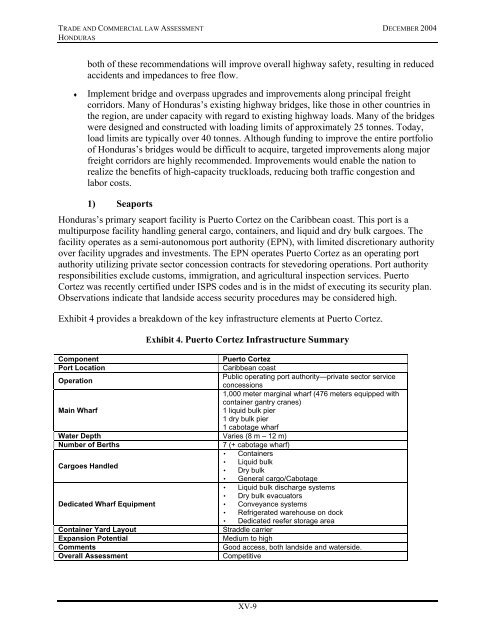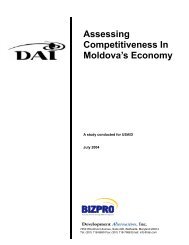Trade and Commercial Law Assessment - Honduras - Economic ...
Trade and Commercial Law Assessment - Honduras - Economic ...
Trade and Commercial Law Assessment - Honduras - Economic ...
You also want an ePaper? Increase the reach of your titles
YUMPU automatically turns print PDFs into web optimized ePapers that Google loves.
TRADE AND COMMERCIAL LAW ASSESSMENT DECEMBER 2004<br />
HONDURAS<br />
both of these recommendations will improve overall highway safety, resulting in reduced<br />
accidents <strong>and</strong> impedances to free flow.<br />
♦ Implement bridge <strong>and</strong> overpass upgrades <strong>and</strong> improvements along principal freight<br />
corridors. Many of <strong>Honduras</strong>’s existing highway bridges, like those in other countries in<br />
the region, are under capacity with regard to existing highway loads. Many of the bridges<br />
were designed <strong>and</strong> constructed with loading limits of approximately 25 tonnes. Today,<br />
load limits are typically over 40 tonnes. Although funding to improve the entire portfolio<br />
of <strong>Honduras</strong>’s bridges would be difficult to acquire, targeted improvements along major<br />
freight corridors are highly recommended. Improvements would enable the nation to<br />
realize the benefits of high-capacity truckloads, reducing both traffic congestion <strong>and</strong><br />
labor costs.<br />
1) Seaports<br />
<strong>Honduras</strong>’s primary seaport facility is Puerto Cortez on the Caribbean coast. This port is a<br />
multipurpose facility h<strong>and</strong>ling general cargo, containers, <strong>and</strong> liquid <strong>and</strong> dry bulk cargoes. The<br />
facility operates as a semi-autonomous port authority (EPN), with limited discretionary authority<br />
over facility<br />
upgrades <strong>and</strong> investments. The EPN operates Puerto Cortez as an operating port<br />
authority<br />
utilizing private sector concession contracts for stevedoring operations. Port authority<br />
responsibilities<br />
exclude customs, immigration, <strong>and</strong> agricultural inspection services. Puerto<br />
Cortez was recently certified under ISPS codes <strong>and</strong> is in the midst of executing its security plan.<br />
Observations<br />
indicate that l<strong>and</strong>side access security procedures may be considered high.<br />
Exhibit 4 provides a breakdown of the key infrastructure elements at Puerto Cortez.<br />
Exhibit 4. Puerto<br />
Cortez Infrastructure Summary<br />
Component<br />
Puerto Cortez<br />
Port Location Caribbean coast<br />
Operation<br />
Public operating port authority—private sector service<br />
concessions<br />
1,000 meter marginal wharf (476 meters equipped with<br />
container gantry cranes)<br />
Main Wharf<br />
1 liquid bulk pier<br />
1 dry bulk pier<br />
1 cabotage wharf<br />
Water Depth Varies (8 m – 12 m)<br />
Number of Berths 7 (+ cabotage wharf)<br />
• Containers<br />
Cargoes H<strong>and</strong>led<br />
•<br />
•<br />
Liquid bulk<br />
Dry bulk<br />
• General cargo/Cabotage<br />
• Liquid bulk discharge systems<br />
• Dry bulk evacuators<br />
Dedicated Wharf Equipment<br />
• Conveyance systems<br />
• Refrigerated warehouse on dock<br />
• Dedicated reefer storage area<br />
Container Yard Layout Straddle carrier<br />
Expansion Potential Medium to high<br />
Comments Good access, both l<strong>and</strong>side <strong>and</strong> waterside.<br />
Overall <strong>Assessment</strong> Competitive<br />
XV-9

















